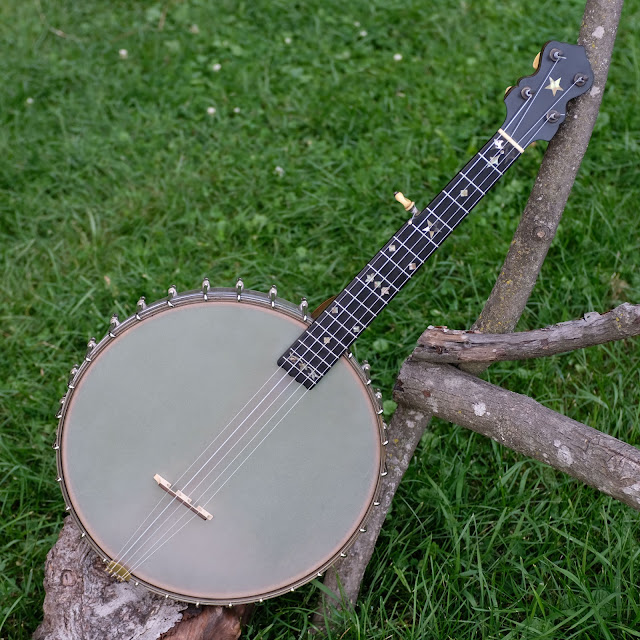1890s Thompson & Odell-made Luscomb Banjeaurine
A banjeaurine is a 5-string banjo with a shortened scale and a large rim. They're usually tuned up from gDGBD to cGCEG in the range of a low-G-tuned ukulele. This made them a perfect lead or solo instrument for use in the banjo ensembles popular in the late 1800s and early 1900s -- the giant rim gives them a tone of power and volume and the higher pitch makes their notes leap right out.
That said, this is quite the banjeaurine. It's high-quality throughout and was made by Thompson & Odell in Boston for the Luscomb brand. It features that brand's all-brass rim that's topped with a wooden tonering (in a reversal of the usual wooden rim topped with a metal tonering). This instrument's owner waited some months for my order of a custom Remo Renaissance head for it to arrive and I was lucky enough to receive it on Wednesday.
It was worth the wait, however, as if you've ever owned a large-diameter-rim banjo with a skin head, you'll know that having to deal with skin's weather-related troubles on a larger rim is enough to make one cry. Aside from installing the head, my other work included a fret level/dress, minor cleaning, and a good setup with Aquila Nylgut strings. The neck is tough enough to take steel, but a period band would've used gut and (not surprisingly and because of that) it sounds excellent with the Nylgut on here right now.
Specs are: 19 5/8" scale, 1 5/16" nut width, 1 1/16" string spacing at the nut, 1 9/16" spacing at the bridge, 13 1/8" head, and 2 1/2" side depth.
Woods are: mahogany neck, ebony fretboard, heel cap, and headstock veneer, and maple lining between layers for trim effect. The inlay in the board is pearl and the nut is bone.
The rim hooks are all replacements and so is the tailpiece (an unplated modern No-Knot),bridge, and head, but the rest of the instrument is original. I especially like the early, 1890s-style Grover Champion pegs with their slightly-different design.
Remo shipped this head with a giant logo on it. I was lucky-enough to steel-wool it off and hide most of the rubbing from that process under the fretboard extension.
Nice cut to that headstock, huh? That's clean work.
The owner supplied me with a 1/2" bridge but it was too low during setup. This 5/8" from my bins is just barely high enough but I think it could really use a 11/16" height to make it more amenable to heavier-handed use. The current setup is 1/16" at the 12th fret which is perfect for fingerpicking but maybe not for a heavy frailer.
The neck has a medium-big, soft-V profile with a flat fretboard. It's a good feel.
Here you can see the nickel-plated brass rim with its wooden tonering sitting on top. Wild, huh?
The two-bolt neck brace with its ebony safety-pads works beautifully.
I had to angle the tailpiece just slightly to align correctly.





















Comments